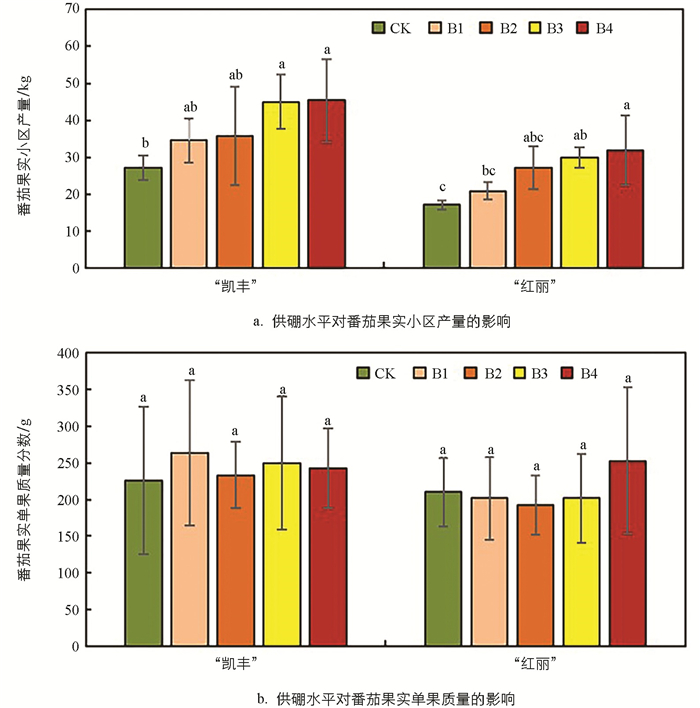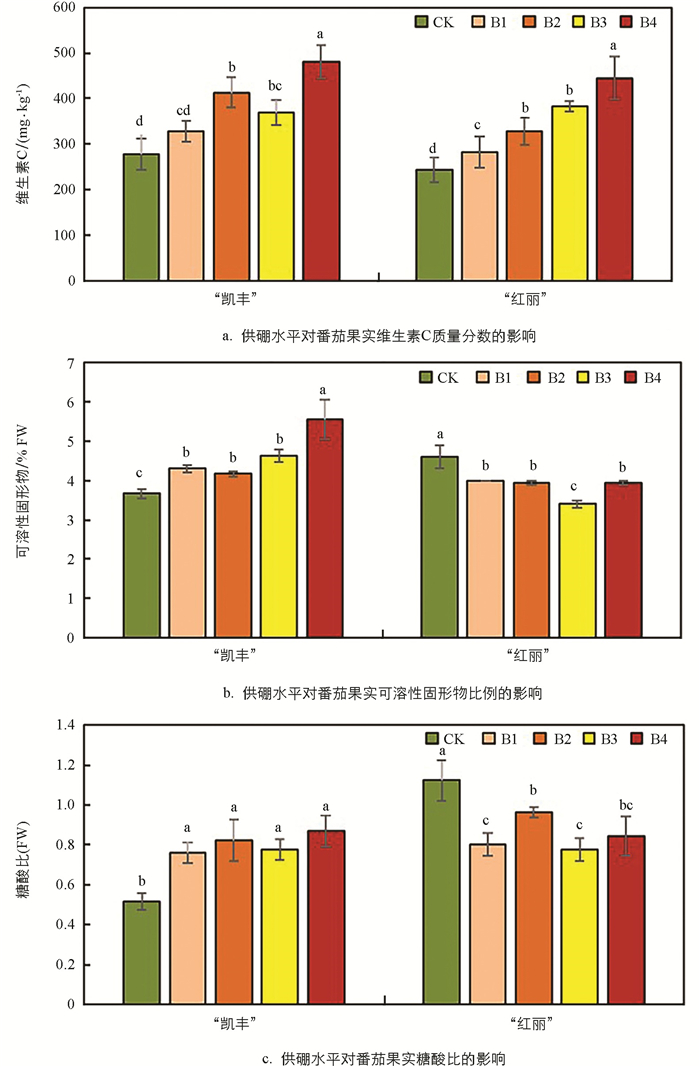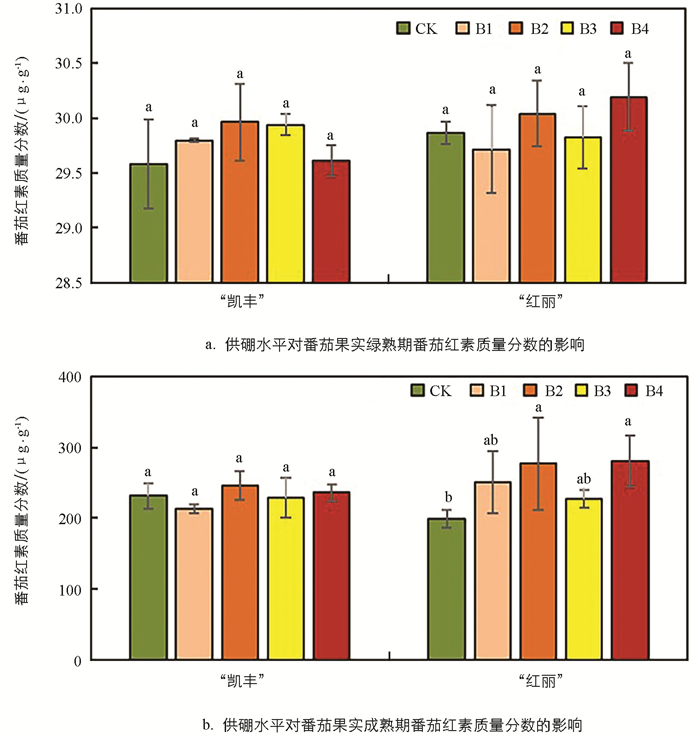-
开放科学(资源服务)标志码(OSID):

-
硼是植物生长发育必不可少的微量营养元素,参与植物的多种生理过程,如碳水化合物代谢、核酸合成、细胞骨架蛋白和氮代谢,同时还参与植物体内酶和生长调节剂的反应过程[1]. 根据全国第二次土壤普查数据,我国低硼和缺硼土壤面积很大,缺硼耕地土壤多达0.33亿hm2以上[2],土壤硼含量呈现由北向南、由西向东逐渐降低的趋势,我国的低硼和缺硼地区主要集中在南方红壤区,干旱和半干旱地区土壤硼元素的含量高于湿润地区[3]. 有研究表明,我国西南地区土壤缺硼现象也较为严重,重庆市土壤处于极度缺硼和缺硼状态,有效硼普遍严重缺乏[4].
李梅兰等[5]研究发现,相较于正常硼肥(4 mg/L)处理,番茄在缺硼(0 mg/L)、多硼(8 mg/L)处理下果实的酸度增加,甜度、维生素C质量分数、番茄红素、总酚和类黄酮质量分数降低,挥发性物质在多硼处理下增多. 徐炜南[6]发现适宜的硼肥处理能够提高番茄果实的营养品质,主要包括可溶性糖、可溶性固形物和番茄红素等品质指标,另外在喷施含1.90 mg/L硼酸营养液处理的番茄果实中,挥发性物质含量和特征香气含量较高. 挥发性物质是广泛存在于高等植物中的一类低分子量代谢物,不仅赋予果蔬特殊风味,影响果实感官性状,还在其他生物活动中起着信息传导和传递的作用[7]. 番茄红素是成熟水果中的主要色素,在抗氧化、清除自由基方面具有重要的作用[8]. 番茄红素属于类胡萝卜素,类胡萝卜素经过催化裂解可以产生芳香类物质,是作物果实颜色和营养品质的重要因素. 在番茄等可食用的肉质水果中,果实中的芳香物质组成会影响香气和风味[9].
中国是世界上番茄种植面积最大的国家,我国番茄种植面积为146万hm2左右,年产量超过5 500万t[10]. 番茄果实品质受基因型、环境条件、与灌溉和施肥相关的农艺管理以及生长阶段的影响[11]. 尽管风味是消费者接受食物的基本要素,但育种计划主要关注产量,导致许多蔬菜的风味显著下降[12]. 近些年,番茄生产大多致力于提高产量,产品质量参差不齐,个别甚至出现番茄品质降低和风味丧失的现象. 随着人们生活水平日益提高,如何改善和提高蔬菜产品品质,尤其是营养、风味品质,已经成为全社会关注的热点问题. 本研究以重庆地区番茄生产上应用较为广泛的2个品种——“凯丰”和“红丽”为试验材料,采用大田试验研究了不同硼水平(0,1,2,4,8 mg/L硼砂)对番茄的营养、风味品质的影响,为进一步开展蔬菜品质调控积累资料.
全文HTML
-
试验于2021年3月在重庆市璧山区七塘镇(106°17′7.55″E,29°46′43.97″ N)的日光温室进行. 供试土壤的基础理化性质为:pH值(水/土=1/1)为6.86,土壤有机质为10.78 g/kg,土壤全氮为1.20 g/kg,碱解氮为161.00 mg/kg,有效磷为410.20 mg/kg,速效钾为397.30 mg/kg,有效硼为0.14 mg/kg;番茄品种为“凯丰”和“红丽”.
-
本试验硼元素质量浓度参照郭世荣[13]的作物微量元素通用用量,即正常硼值的范围为0.20~0.50 mg/L,在营养液中加入5个质量浓度的硼砂(0,1,2,4,8 mg/L),使硼元素质量浓度分别为:0,0.11,0.23,0.45,0.90 mg/L,并分别用CK,B1,B2,B3和B4表示不同硼质量浓度处理. 营养液配方选用课题组前期已确定的营养液:20μmol/L蔗糖(0.684%);0.1wt%甘氨酸;0.2wt% EM菌剂;0.2%磷酸二氢钾;0.1%腐植酸钠. 稀释1 000倍,喷洒量根据当地农户常规叶面肥用量进行. 每个处理重复3次,随机排列.
番茄栽培种植日常管理由当地人员负责,保证管理一致. 在第一穗果膨大期开始喷施第一次,以后间隔两周喷施一次,总共喷施3次. 在3次喷施过后,取第三穗成熟期果实,先用自来水冲洗干净,然后用去离子水清洗3次,一部分鲜样用于有机酸、维生素C、硝酸盐、可溶性固形物等指标测定;一部分放于超低温冰箱-80 ℃保存;剩余样品在试验室干燥器105 ℃下杀青15 min,60 ℃下烘干称质量,然后在配有塑料外壳和不锈钢刀片的家用混合器中均质粉碎.
-
pH值采用水土比1∶1的方法测定;土壤有机质、全氮、碱解氮、有效磷、速效钾等基本理化指标用常规方法测定[14].
-
维生素C采用2,6-二氯靛酚滴定法(GB5009.86-2016)测定;采用ATC手持折光仪(北京万成北增精密仪器有限公司,型号WZ-108)测量番茄心室汁液的可溶性固形物质量分数;番茄红素采用高效液相色谱法[15]测定.
挥发性代谢物采用李晓颖等[16]和李彦华[17]的方法测定. 按照下面公式计算各挥发性化合物质量分数:
式中:Cx为挥发性化合物x的质量分数(μg/kg);Ax,Ai分别为挥发性化合物和内标峰面积;ms,mi分别为内标物质量(μg)和样品质量(g).
氨基酸组分参照冯德玉[18]的方法,在日立L-8800型全自动氨基酸分析仪中进行测定. 参照FAO/WHO最佳配比模式,将各样品氨基酸含量转化为每克蛋白质中含氨基酸毫克数来评定氨基酸营养价值. FAO/WHO是粮农组织/世界卫生组织蛋白质质量评价联合专家建议使用蛋白质消化率校正氨基酸评分(Protein Digestibility Corrected Amino Acid Score,PDCAAS)方法,在评价氨基酸方面被广泛的运用[19]. 氨基酸比值(RAA)、氨基酸比值系数(RC)、氨基酸比值系数分(SRC)、氨基酸质量分数阀值比(RCT)分别按照公式(1),(2),(3)和(4)进行计算[20]. SRD是RC的标准偏差.
-
采用He等[21]的多级模糊综合评价(Multi-Level Fuzzy Comprehensive Evaluation,MFCE)体系,并依据实际情况略作修改. 将番茄的所有指标划分为因子和子因子,进行子集的构建,然后进行权重计算,最后得出综合评价,相关具体计算步骤如下:
-
1) 将番茄的所有指标归类为生长、营养品质和风味品质3种因素.
式中:U1,U2,U2分别是生长、营养品质和风味品质指标.
2) 将所有二级指标分类并表示为子因素. 将单果质量(g)、产量(kg)归类为U1,维生素C、氨基酸、番茄红素、可溶性固形物比例归类为U2,挥发性物质归类为U3.
-
每个因素及其相关子因素都有一组相应的评价值. 试验共有5次,产生5个评价值,定义如下:
式中:Vi为各因子的评价值;Vij为各子因子的评价值.
-
1) 层次分析法确定因素权重
层次分析法是目前应用最广泛的评价方法,因为它可以使用简单的评价方法系统地评价对象. 层次分析法的特别之处在于可以利用问卷结果建立判断矩阵,将总决策分解为目标、因素和子因素层. 通过分析指标之间的关系,建立比较矩阵,将复杂问题分解为若干个标准和指标. 每个指标都被量化和比较,以确定分层模型中每个因素(ai)和子因素(aij)的单独权重. 详细计算方法参考文献[22].
2) 熵权法确定子因素权重
熵权法通常用于确定指标的客观权重,能有效反映数据所隐含的信息,具有很强的可操作性. 对于使用熵权法计算子因子权重,子因子集的实测数据初步标准化如下:
式中:Xjz为实测数据;m为评价指标个数;n为评价对象个数.
然后计算子因子集的信息熵. 具体来讲,第j个牵引信息熵(Eij)被定义为:
其中Eij是第i个因子的第j个子因素的信息熵. 第j个子因子的熵权重Wij确定如下:
3) 多级模糊评价值的计算
因子集合的单级模糊评估使用以下公式进行:
式中:biz为第i个因子集的模糊评价指标; rjz为标准化数据.
此外,描述的子因素集的二次模糊评价如下:
式中:Bz为第z次处理的多级综合模糊评价指标.
-
试验数据采用平均值±标准差表示. 利用Microsoft Excel 2019专业增强版进行数据处理和作图,SPSS 23.0软件进行单因素方差分析,通过邓肯(Duncan)新复极法分析平均值之间的显著性差异(p<0.05).
1.1. 试验材料
1.2. 试验方法
1.3. 测定指标与方法
1.3.1. 土壤的基本性质测定
1.3.2. 主要营养品质的测定
1.3.3. 多级模糊综合评价
1.3.3.1. 模糊评价因子和子因子集的构建
1.3.3.2. 因子和子因子评估集的构建
1.3.3.3. 多级模糊评价因素权重的确定
1.4. 数据处理与统计分析
-
供硼水平对番茄小区产量的影响如图 1a所示,随着供硼水平的增加,2个品种番茄的小区产量均呈现增加趋势. 与对照相比,硼处理后“凯丰”番茄产量提高了27.28%~67.21%,“红丽”番茄产量提高了22.23%~86.25%. “凯丰”和“红丽”2个品种番茄都在B4处理下产量达到最大值,但随着供硼水平的增加,小区产量的增速逐渐降低.
由图 1b可知,硼处理对“凯丰”和“红丽”2个品种番茄的单果质量影响效果不同,但各处理之间差异都不显著. “凯丰”番茄的单果质量整体上呈先增加后减少趋势,在B1处理下达到最大值,是对照的1.16倍,各处理单果质量较对照提升了2.97%~16.39%. 然而“红丽”番茄的单果质量先减少后增加,在B2处理下达到最小值,是对照的91.66%.
-
番茄收获时,用新鲜果实样品测定维生素C质量分数、可溶性固形物和糖酸比. 如图 2a所示,随供硼水平的增加,2个品种中的维生素C质量分数都逐渐增加(除了“凯丰”在B3处理外),相较对照,“凯丰”维生素C质量分数提高了17.84%~73.31%,“红丽”维生素C质量分数提高了16.27%~83.42%. 在B4处理状态下维生素C质量分数达到最大值,“凯丰”和“红丽”的维生素C质量分数是对照的1.73倍和1.83倍. 由图 2b和图 2c可知,与对照组相比,硼处理对番茄果实中的可溶性固形物比例和糖酸比有显著影响,但对“凯丰”和“红丽”影响效果不同. 随硼处理水平的增加,“凯丰”的可溶性固形物比例和糖酸比增加,各处理与对照相比具有显著性差异,在B4处理下,“凯丰”的可溶性固形物比例较对照组提高了51.82%,糖酸比是对照的1.67倍. 然而,硼处理对“红丽”的可溶性固形物比例和糖酸比产生负面影响,在B3处理下,“红丽”可溶性固形物与糖酸比都达到最小值. 值得注意的是,在硼处理(1~8 mg/L)范围内,“红丽”的可溶性固形物比例都呈现先减少再增加的趋势.
-
从表 1可以看出,采用GC-IMS共检测出了成熟期番茄果实46种挥发性物质,其中主要包括醛类、醇类、酮类、烃类、脂类等. 在本试验中,就挥发性物质成分而言,“凯丰”品种中,反-2-己烯醛、2-乙基己醇、香叶基丙酮、6-甲基-5-庚基-2-酮、双戊烯、异硫氰酸烯丙脂在不同硼处理下均可检出;在“红丽”品种中,己醛、反-2-己烯醛、香叶基丙酮、β-紫罗兰酮、双戊烯、水杨酸甲酯、异硫氰酸烯丙脂、丁香酚、愈创木酚在不同硼处理下均可检出. 有研究发现番茄的甜味和反-2-己烯醛、顺己烯醇、甲基庚烯酮具有相关性,酸味和乙酮、紫罗兰酮、顺己醇呈相关性,湿度和可溶性固形物都有相关性. 这些组分在番茄成熟过程中的变化趋势已有报道[23].
由表 2可知,在“凯丰”果实中鉴定出7种特征香气成分物质,“红丽”果实中鉴定出9种特征香气成分物质. 其中己醛、反-2-己烯醛、己醇、反-2-庚烯醛、和顺-3-己烯-1-醇赋予番茄果实青草香,只有反-2-己烯醛在2个品种所有处理中都可以检测到,反-2-己烯醛是一种小分子挥发性物质,在调节植物生长发育和抵抗各种环境胁迫中发挥重要作用[24]. “凯丰”反-2-己烯醛质量分数随着供硼水平的升高呈现先增高再降低的现象,而“红丽”中反-2-己烯醛质量分数总体呈现下降趋势,在B4处理下有所升高,但在B4处理下“红丽”的反-2-己烯醛相对质量只有“凯丰”的29.96%. β-紫罗兰酮和6-甲基-5-庚基-2-酮赋予果实花果香,在2个品种中都有部分被检测到. 苯乙醇和苯乙醛赋予果实花香味,在“凯丰”中可以检测到,“红丽”中几乎检测不到.
-
氨基酸是果熟中必不可少的香气和风味化合物,可以作为挥发性物质的前体成分[25]. 为此我们检验了番茄果实氨基酸的组成和质量分数. 由表 3可知,我们在“凯丰”和“红丽”果实中共检验出17种氨基酸,7种人体必需氨基酸,包括赖氨酸、亮氨酸、异亮氨酸、甲硫氨酸、苯丙氨酸、苏氨酸和缬氨酸,10种人体非必需氨基酸. 随着供硼水平的增加,“凯丰”品种的必需氨基酸占总氨基酸的比值(EAA/TAA)呈现先增加后减少的趋势,“红丽”在B3处理时不再增加,在B4处理时的比值略低于B2. 与对照相比,“凯丰”的EAA/TAA提升了7.66%~13.03%,在B3处理下达到最大值,是对照的1.13倍;“红丽”的EAA/TAA提升了8.87%~17.61%,在B2处理下达到最大值,是对照的1.18倍. “凯丰”和“红丽”的总氨基酸质量分数受到硼作用后的变化趋势略有差异. “凯丰”的亮氨酸、异亮氨酸、苯丙氨酸、缬氨酸和丙氨酸都在B1处理时达到最大,分别是对照的1.51,1.46,1.36,1.36和1.54倍,在B2,B3处理时低于对照,在B4处理下稍微恢复到B1水平. 与之相反的是,“红丽”各氨基酸组分随着供硼水平的增加整体上呈现先降低后增加再降低的趋势,在B3处理下普遍增加最多,但仍然低于对照. 与对照相比,“红丽”亮氨酸、异亮氨酸、苯丙氨酸、缬氨酸和丙氨酸质量分数分别降低了35.80%~79.42%,36.30%~77.40%,34.38%~72.92%,30.00%~74.11%和39.11%~77.72%.
氨基酸比值(RAA)和氨基酸比值系数(RC)值越接近1,表明其EAA质量分数越接近FAO/WHO推荐值,RC值>1表示该氨基酸过剩,RC值<1则该氨基酸相对不足,氨基酸比值系数分(SRC)值用来评价食物中的蛋白质的营养价值[26]. 由表 4可知,“凯丰”的赖氨酸RC值整体最小,苏氨酸和异亮氨酸略低,其余氨基酸接近1. “红丽”的异亮氨酸RC值整体最小,苏氨酸、赖氨酸和酪氨酸+苯丙氨酸略低,其余氨基酸数值接近1. 所以“凯丰”和“红丽”的第一限制氨基酸分别为赖氨酸、异亮氨酸. 对于必需氨基酸的SRC值,“凯丰”的SRC值从大到小为:CK,B2,B3,B4,B1,“红丽”的SRC值从大到小为:B3,CK,B1,B4,B2. “红丽”的SRC值在B1,B2和B4处理下低于60,表明此处理下的番茄果实EAA质量分数不均衡.
-
番茄红素是成熟水果中的主要色素,在抗氧化、清除自由基方面具有重要的作用[27]. 有研究认为,番茄红素作为类胡萝卜衍生的香气化合物,可能是决定一些香气的关键代谢物质[28]. 由图 3可知,随着供硼水平的增加,“凯丰”的番茄红素质量分数在绿熟期、成熟期总体上都呈现先增加后减少的趋势. 在绿熟期,“凯丰”的番茄红素质量分数在B2处理下达到最大值,为29.96 μg/g,而后随着供硼水平的增加,番茄红素质量分数有所下降. 同样是绿熟期,“红丽”在B2、B4处理下相较于对照分别增加了0.59%和1.08%,然而“红丽”的番茄红素质量分数在B1和B3处理下低于对照. 2个品种的番茄红素质量分数在绿熟期各处理间都无统计学意义.
在成熟期,相较于对照,“红丽”品种在B2、B4处理番茄红素质量分数有统计学意义. 在这一时期,“凯丰”的番茄红素质量分数都在B2处理下达到最大值,为245.80 μg/g. “红丽”品种的番茄红素质量分数都在B4处理下达到最大值,为280.46 μg/g,相较于对照提升了40.80%.
-
本试验中番茄的多级模糊综合评价分析分别采用层次分析法和熵值法计算第一层因子(ai)、第二层子因子(wij)的权重(表 4),然后将两组权重合并在一起. 表 5为所有处理下的模糊评价值. 处理的模糊评价值越高,处理后番茄的整体情况越好. 结果表明:对于“凯丰”而言,综合评价值B1与B2相等,并依次大于B3,B4,CK,对于“红丽”而言,综合评价值从大到小依次为:B2,B4,CK,B3,B1. 整体上来说,“凯丰”和“红丽”的综合评价都在B2处理下达到最大值,分别为0.24,0.28.
2.1. 供硼水平对番茄果实单果质量和产量的影响
2.2. 供硼水平对番茄果实维生素C质量分数、可溶性固形物比例和糖酸比的影响
2.3. 供硼水平对番茄果实挥发性物质组成及质量分数的影响
2.4. 供硼水平对番茄果实氨基酸组分及质量分数的影响
2.5. 供硼水平对番茄果实番茄红素质量分数的影响
2.6. 基于多级模糊综合评价分析番茄生长、营养及风味品质的最佳供硼水平
-
单果质量是衡量外界调控因子处理对植物生长影响的重要指标之一[29]. 在本试验中,番茄果实单果质量在各处理之间差异无统计学意义. 供硼处理显著增加了番茄小区产量,在B4处理下效果最为显著,然而同比增速在逐渐降低,这可能是由于硼对生殖生长发育、生殖组织的刺激有关[30];徐芳森等[31]认为缺硼会导致油菜花器官发育异常,花药退化,花粉粒稀少,花而不实;曾紫君等[32]研究发现,棉花缺硼会出现花梗、萼片、花瓣和雌雄蕊的解剖结构异常,特别是缺硼使花药的绒毡层延迟消失并且膨大,花粉内陷,空瘪的花粉粒成团块状,子房壁细胞排列紊乱,珠被、珠心结构层次不清等,并最终导致“蕾而不花”的现象. 郭丽璇等[33]在红壤地区直播油菜施硼的研究中发现,硼对产量构成因子——单株角果数和每角粒数,产生了显著性影响(增加),但对千粒质量的影响不显著(甚至在部分试验中下降),说明施硼后产量构成因子(单株角果数、每角粒数)的增加是油菜增产的主要原因,这也进一步验证了我们的试验结果.
维生素C是人类必需的微量营养物质,其质量分数也与果蔬营养品质相关. 为了确保人体正常的生理功能,必须将维生素C作为饮食结构的一部分[34]. 维生素C也是一种重要的抗氧化剂,有助于清除植物中的活性氧[35]. 在本试验中,随着供硼水平的增加,番茄果实中维生素C质量分数逐渐增加,这表明“凯丰”和“红丽”番茄果实在硼处理后抗逆能力有所增强. 刘盼盼等[36]在对菊花进行硼肥处理时,发现施用0.50~2.50 mg/kg硼肥显著增加了菊花叶片维生素C的质量分数,与本试验结果一致. 随着供硼水平的增加,“凯丰”番茄果实可溶性固形物比例逐渐升高,“红丽”则先降低后升高.
氨基酸是果实形成鲜味品质的重要组成部分,是判断及决定番茄果实品质的关键因素. 氨基酸可以参与到果实内部其他的品质特征成分的形成,同时也是植物的初级代谢物与次级代谢物相连接的重要因素[37]. 在我们的研究中,适宜硼处理下果实氨基酸质量分数增加,必需氨基酸与总氨基酸的比值也增加,结果证实了之前的研究. 适宜的硼处理之所以能够增加氨基酸质量分数,可能是因为硼对氮代谢产生一定程度的促进作用,使与之相关的酶活性增加,进而促进了氨基酸的合成[18]. 有研究者发现,硼缺乏可以促进天冬酰胺合成酶对铵的同化,进而导致天冬酰胺增加和谷氨酰胺合成酶活性降低,造成一些氨基酸含量降低[38]. 我们还采用了氨基酸比值系数法对番茄果实氨基酸的营养价值进行分析,“凯丰”和“红丽”的赖氨酸、苏氨酸、异亮氨酸的RC值都略低. 综合考虑氨基酸的组成和含量,“凯丰”氨基酸营养价值在B2处理最优,“红丽”氨基酸营养价值在B3处理最优.
番茄红素是番茄果实的关键成分,主要负责成熟番茄果实的着色及品质. 番茄红素含有多种抗氧化剂,能够保护身体免受有害化合物自由基的伤害,对人体膳食健康有重要意义. 番茄果实中的番茄红素质量分数会受栽培环境[39]、成熟期[40]、农艺因素[41]和加工[42]的影响. 此外,番茄红素裂解后会进而影响挥发性物质的合成. 之前的研究发现,通过叶面喷施硼肥,番茄果实中番茄红素质量分数、类胡萝卜素质量分数都呈先增加后减少的趋势,在含1.80 mg/L硼酸营养液处理下,类胡萝卜素物质质量分数最高[6]. 我们的结果表明,在不同供硼水平处理下“凯丰”和“红丽”的番茄红素质量分数在绿熟期和成熟期表现出相似的变化趋势,都是先增加后降低,同时适宜的硼处理(B2)能明显增加番茄红素质量分数,这与上述研究结果一致. 同时我们还发现番茄果实中番茄红素质量分数受发育阶段的影响,随着发育阶段的进行,番茄组织中番茄红素越来越多. 邵旭日等[43]在番茄叶面喷施不同浓度硒肥后,发现随着供硒水平的增加,番茄红素质量分数先增加后减少,番茄红素也随着发育期的进行而积累,该特性与本研究结果一致. 另有研究[44]通过基施硼肥也发现不同硼水平对番茄果实番茄红素质量分数的影响极有统计学意义(p<0.01),其中适宜硼处理(2 kg/hm2)的番茄果实中番茄红素质量分数最高,为0.34 mg/kg.
番茄风味品质形成的关键因素是果实挥发性物质的种类和质量分数,其在很大程度上决定了消费者对番茄果实的偏爱程度[45]. 挥发性物质根据合成的前体物质又可以分为脂肪酸、氨基酸和类胡萝卜素等[18]. 这些前体物质来自于植物体内卡尔文循环、糖酵解、莽草酸途径以及甲羟戊酸途径等多种代谢途径[46]. 在本试验中,适宜的施硼处理可以增加番茄果实中挥发性物质的总质量分数和数量. 冯德玉[18]在对大白菜基施硼肥的研究中也发现,适宜的硼处理(1 mg/L)可以增加大白菜中挥发性物质的总质量分数. 类胡萝卜素氧化裂解化合物在类胡萝卜素裂解双加氧酶的作用下,直接由类胡萝卜素裂解合成,并且它们的产生与其直接前体类胡萝卜素成分的水平密切相关[47]. 6-甲基-5-庚基-2-酮直接来自番茄红素,香叶基丙酮来自于ζ-类胡萝卜素,香叶醛和柠檬醛来自于番茄红素及其四萜前体物质[48]. 我们的结果表明,适宜的硼处理(1~2 mg/L)可以增加上述物质的含量,尤其是6-甲基-5-庚基-2-酮含量明显增加,这与徐炜南[6]的研究结果一致,在叶面喷施1.90 mg/L硼酸、含3.80 mg/L硼酸营养液能显著增加6-甲基-5-庚基-2-酮含量. 在本试验中,我们鉴定出3种氨基酸衍生物,分别为苯乙醇、苯乙醛和水杨酸甲脂,苯乙醇和苯乙醛在酒精水溶液或水溶液中被描述为“花香”“果香”和“玫瑰香”. 在番茄果实中,苯丙烷是由苯丙氨酸通过一系列酶合成的,包括氨基酸脱羧酶(AADC)、胺氧化酶和苯乙醛还原酶(PAR)[49]. 第一步也是限速步骤由AADC执行,它将苯丙氨酸转化为苯乙胺. 这表明本试验中硼处理引起的苯丙烷类化合物增加或者减少可能是由于AADCs相关基因表达及酶活性的上调、下调. 尽管与苯丙烷具有相同的前体,但水杨酸甲酯是从苯丙氨酸分解代谢途径的一个分支合成的,其生产是通过使用苯丙氨酸解氨酶(PAL),将苯丙氨酸转化为反式肉桂酸而引发的[50].
灰色关联分析、赋权法、博弈论和主成分分析已被广泛应用于作物生长发育的评价中[51-53]. 刘洋等[54]利用赋权法对黄瓜育苗品质进行综合评价. 然而,有些方法受人为因素的影响,部分分析基于原始数据进行评估,导致最终评估结果存在不确定性[55]. MFCE框架是一种将定性和定量数据相结合以提高精度的模糊算法,从而获得比上述方法更广泛、更准确的评价结果[21]. Yao等[56]提出了一种基于诱发滑坡灾害的8个环境条件的模糊系统,其中MFCE系统采用了多层次分析系统中的5个滑坡风险因素,该模型能够成功覆盖大部分有效因素,确定最优设计方案. 由于MFCE在处理多个指标方面的优越性,因此可以取得稳定的应用结果. 在本试验中,为了协调各指标对番茄综合生长的影响,我们采用层次分析法和熵值法确定因子和子因子的权重,然后应用模糊数学原理对权重进行MFCE,得到最大的MFCE值,来评价不同供硼水平下番茄风味品质的最优效果.
-
硼处理显著增加了2个番茄品种的小区产量,“凯丰”和“红丽”2个品种番茄都在B4 (4 mg/L)处理下达到最大值. 随着供硼水平的增加,“凯丰”和“红丽”的维生素C质量分数整体上呈逐渐增加的趋势. 与对照相比,2个番茄品种在不同硼供应下的可溶性固形物与糖酸比都有统计学意义,不同的是硼处理对2个品种的影响效应不同.在本试验中共检测出了成熟期新鲜番茄果实46种挥发性物质,就挥发性物质成分而言,己醛、反-2-己烯醛、2-乙基己醇、香叶基丙酮、β-紫罗兰酮、双戊烯这些与番茄风味相关的物质在2个品种均有被检测到. “凯丰”总氨基酸含量和单个氨基酸含量随着供硼水平的增加呈现先增加后减少再增加的趋势,“红丽”则呈先减少后增加再减少的趋势,“凯丰”品种的必需氨基酸占总氨基酸的比值呈现先增加后减少的趋势,在B3处理下达到最大值,“红丽”品种的必需氨基酸占总氨基酸的比值则在B2处理下达到最大值. 硼处理对“凯丰”品种绿熟期、成熟期的番茄红素质量分数无统计学意义,而对于成熟期的“红丽”而言,在B2、B4处理下有统计学意义. 结合多级模糊综合评价分析模型,“凯丰”和“红丽”产量和品质的综合评价在B2处理下最优.




 下载:
下载:

